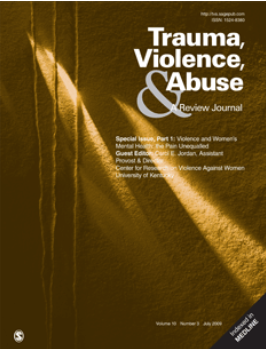Measures Assessing Barriers and Facilitators to Post-Sexual Violence Services: A Critical Review.
IF 5.4
1区 社会学
Q1 CRIMINOLOGY & PENOLOGY
引用次数: 0
Abstract
Sexual violence (SV) is a significant public health problem associated with poor health, social, and economic outcomes. Although services exist to support survivors of SV, many do not access these services. This critical review examines measures used to assess barriers and facilitators to post-SV services and whether these measures address the full breadth of concerns among SV survivors, particularly those who hold marginalized identities. Eligible studies had to be original and peer-reviewed, include a measure of barriers or facilitators to service-seeking, and focus on SV survivors. We reviewed 10 measures that assessed barriers and/or facilitators to mental health, medical, advocacy, and legal services among SV survivors. These measures were designed for and/or applied to survivors of intimate partner violence, human trafficking, military sexual trauma, child sexual abuse, and adult sexual assault. Populations sampled included college students, military personnel, gender and sexual minority youth, women living with HIV, and crime victims seeking legal services. Using a social-ecological model approach, we assessed barriers at the individual, interpersonal/community/provider, and structural/organizational levels. Barriers at the community level were largely absent, and only three measures addressed facilitators. Five measures provided some psychometric data with survivors, and only three incorporated survivor feedback in their development. Four measures included some cultural and/or identity-specific factors. Future research should prioritize the development of trauma- and violence-informed measures that incorporate survivor feedback and address diverse cultural and identity contexts to improve service access and utilization.评估性暴力后服务障碍和促进因素的措施:一项批判性审查。
性暴力是一个与不良健康、社会和经济结果相关的重大公共卫生问题。虽然存在支持性暴力幸存者的服务,但许多人无法获得这些服务。这篇重要的综述审查了用于评估性侵后服务障碍和促进因素的措施,以及这些措施是否解决了性侵幸存者,特别是那些拥有边缘化身份的人的全面关切。符合条件的研究必须是原创的,经过同行评审,包括对寻求服务的障碍或促进因素的衡量,并关注性侵幸存者。我们回顾了评估性暴力幸存者在心理健康、医疗、宣传和法律服务方面的障碍和/或促进因素的10项措施。这些措施是为亲密伴侣暴力、人口贩运、军队性创伤、儿童性虐待和成人性侵犯的幸存者设计和/或适用的。样本人群包括大学生、军人、性别和性少数群体青年、感染艾滋病毒的妇女和寻求法律服务的犯罪受害者。使用社会生态模型方法,我们评估了个体、人际/社区/提供者和结构/组织层面的障碍。社区层面的障碍基本上不存在,只有三项措施涉及促进者。有五个测试提供了幸存者的一些心理测量数据,只有三个在他们的发展中纳入了幸存者的反馈。四项测量包括一些文化和/或身份特定因素。未来的研究应优先考虑制定创伤和暴力知情措施,包括幸存者的反馈,并解决不同的文化和身份背景,以改善服务的获取和利用。
本文章由计算机程序翻译,如有差异,请以英文原文为准。
求助全文
约1分钟内获得全文
求助全文
来源期刊

Trauma Violence & Abuse
Multiple-
CiteScore
13.60
自引率
7.80%
发文量
131
期刊介绍:
Trauma, Violence, & Abuse is devoted to organizing, synthesizing, and expanding knowledge on all force of trauma, abuse, and violence. This peer-reviewed journal is practitioner oriented and will publish only reviews of research, conceptual or theoretical articles, and law review articles. Trauma, Violence, & Abuse is dedicated to professionals and advanced students in clinical training who work with any form of trauma, abuse, and violence. It is intended to compile knowledge that clearly affects practice, policy, and research.
 求助内容:
求助内容: 应助结果提醒方式:
应助结果提醒方式:


